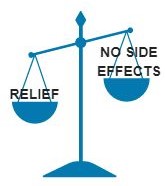12 5.4: Cannabis in Pain Management
Learning Objectives
After reading this section, you will be able to:
- List some reasons why someone would turn to medical cannabis
- Describe what the best way research on pain treatment is conducted
- Explain what studies say on the treatment of migraines and neuropathy
Why Choose Cannabis?
The medical use of cannabis is still a novel therapeutic technique. Research for treating neurological diseases is still being done in order to discover its potential beneficial effects on neurodegenerative disorders such as Multiple Sclerosis, Alzheimer’s Disease, and ALS. However, it’s not uncommon for most people to use it in order to help with other problems. For hundreds of years, people have been using cannabis as a way to treat acute and chronic pain. In fact, treating pain is one of the biggest reasons for medical cannabis use.
For many people who turn to medical cannabis, using traditional methods to manage pain may not be an option. For example, most people with bronchial asthma have an allergy to common analgesics and may experience anaphylactic shock. Asthma is not an uncommon condition, so many individuals may desperately turn to unsafe methods to self-medicate in order to find relief.
In addition, using cannabinoids may actually be a safer option all together for everyone. Ever since the early 2000’s, the number of people who have died from an opioid overdose have tripled in North America (Figure 4.1). On the other hand, it is almost impossible to overdose on cannabis. However, this fact is often overlooked because of the negative stigma associated with it.

How Do We Know It Works?
Performing studies on the efficacy of drugs on pain can be difficult since pain itself is subjective and hard to measure in a standardized way. This is why it’s important to incorporate a double-blind placebo-control group in the study.
YOU CAN(NABIS) LEARN MORE…
A placebo is a treatment that will have no effect on the participant. A double-blind study is one in which neither the researchers nor the participants know if they will be assigned to the treatment group or the placebo group. This removes the possibility of bias.

Thankfully, studies like this have been done, and the findings confirm that those who were given THC reported significant improvement in pain levels compared to the placebo group. In addition, these studies also reported that higher THC doses correlated with increased relief from pain, but the most effective dose itself will vary from person to person. Ultimately, the optimum concentration level would be one that provides relief without causing unbearable side effects.
Examples of Treatment
Headaches

As mentioned before, the ECS is active in areas that detect pain. For those who deal with chronic pain such as severe headaches, it is theorized that they may have a deficiency of endocannabinoids which results in a poorly functioning ECS, leading to a malfunctioning nociceptor system. Researchers have confirmed the hypothesis that modulating the ECS with cannabis derivatives could help restore homeostasis. This will eventually alleviate symptoms of pain in people who suffer from migraines.
Neuropathy
In addition to migraines, people also seek out pain remedies for neuropathy. In a mouse model with neuropathic pain, the researchers tested to see if a combination of THC and CBD would be an effective treatment. After observing the mice’s behavioral response to the treatment, it was confirmed that low doses of THC and CBD could be a therapeutic way to treat neuropathic pain. In another double-blind, placebo study done in a clinical trial on humans, the researchers discovered that the treatment group had significantly better outcomes than the placebo group. Another study displayed evidence for reducing chronic neuropathic pain through smoked THC and naxibimols. This further proves that medical cannabis could be an effective and safe way to treat individuals with acute and chronic pain.
YOU CAN(NABIS) LEARN MORE…
The most common form of neuropathy is peripheral neuropathy. This is a condition where one’s peripheral nerves are damaged, causing numbness, weakness, and pain in the hands and feet. This often develops because of diabetes.
Challenge Yourself!
